Every once in a while I turn down a street in New York and suddenly think, “How have the bulldozers and the glass towers not obliterated this one?” Lispenard Street is one such place, a quiet street of a few blocks that is seemingly forgotten just one block south of the crazy, hustle-bustle free-for-all of Canal Street. If Canal Street is all elbowing and rushing, Lispenard is room to stretch out and walk slowly.
On Lispenard, a single building feature transports one to another era. Walk along Lispenard and look up at the elaborate bracketed cornice crowning 54 Lispenard to see the intricate inscription “Erected 1867” on the arched pediment at the center. It’s a building on the south side of the street, like many of the others along Lispenard and in Tribeca East a “store and loft” building – many four- and five-stories-high and about 25-feet-wide – where merchants in the mid-19th century sold and transported dry goods and textiles.
It was this and another building just a little farther east, 60-62 Lispenard, that first caught my eye and set off an exploration that ultimately felt like I was back in the 1800s, sensing a place and time in which New York merchants created proud and beautiful palaces marked by cast-iron storefronts and the flourishes and details that recall Old Europe. The neighborhood then was the hub of an international trade in things such as fancy goods, notions, hosiery, linens, artificial flowers, and jewelry.
Ironically, 21st century technology – combined with taking a few moments to stop, look up, and observe – put me in the experience of the 19th century. On my smart phone, I found the 1992 New York City Landmarks Preservation Commission (LPC) report designating Tribeca East as a historic district. As I walked on Lispenard between Broadway and Church Street, I read about who designed and constructed a number of the buildings, who occupied them, and what their businesses were.
This block has no fancy restaurants or boutiques like other parts of Tribeca; it’s a mix of residential buildings, long-time businesses like a small barber shop, and a few worse-for-wear structures with peeling paint, graffiti, or crumbling facades. It’s easy to walk right by these places until one looks up and takes them in.
60-62 Lispenard Street
I was cutting across Lispenard Street on a walk, with the idea of avoiding Canal Street’s crowds, when I noticed 60-62 Lispenard St., close to the Broadway end of the block. It’s a beauty. With its Roman buff-colored brick, stone, multiple rounded arches, and classical detailing, the building has a sunny ambience, even with a little grime on it. For a moment it was easy to feel like I was in Italy.
60-62 Lispenard Street
The classical details and fine brickwork on 60-62 Lispenard Street
Gilbert Schellenger, the architect for many townhouses, apartment houses, and loft buildings in New York, designed this Renaissance Revival structure for the New York Building and Improvement Co. It was constructed in 1895, a few decades later than many of the remaining 19th century buildings on this block of Lispenard.
Its design and materials are impressive. As my eyes moved from one element to another, I was struck by how its elements work together to be so eye-pleasing and harmonious. The archways are so graceful and fluid. The stonework is carved with beautiful, intricate classical motifs. All of this seems almost laced together by the “bull-nose brick” of the pilasters and arches, which are bricks with rounded, curved edges that give the building a softer, yet strong feeling.
The arches, stone, and “bull-nose brick” of 60-62 Lispenard Street
This building has had at least one very noteworthy resident during its 116-year history, according to the LPC report. One of New York City’s mayors once lived here after his days in office: William R. Grace, who was elected to lead the city twice in the 1880s. An immigrant who was poor when he arrived from Ireland as a teen, Grace made a fortune in international trade, primarily by forging commerce with South America. Grace founded a company in 1854 in Peru. After relocating to New York, he began triangular trade among the United States, South America, and Europe. He later pioneered direct steamship service between New York and the west coast of South America.
54 Lispenard Street
If you are walking east to west on Lispenard Street, no. 54 is among the first that reveals the street’s particular place in history. Seeing the “Erected 1867” inscription in the central pediment, I scanned the building tops along this stretch and discovered that many had inscriptions signaling people had built them within a year or two of each other, in the mid-1860s. These were heady times as America’s Industrial Revolution was taking hold, and Tribeca became an international center for shipping and selling dry goods. Merchants and traders replaced smaller two-story masonry buildings on Lispenard Street with larger four- and five-story structures with cast-iron storefronts and large lofts above for all kinds of goods. It was, thus, part of a boomtown for a time.
A list of those who occupied this building reflects the trading that was once centered in the neighborhood. Architect Isaac Duckworth, who was responsible for many buildings in Tribeca, designed it for Lewis Duhain, Jr., an importer of flowers, the LPC report notes. Its occupants have included a fancy-goods merchant; a company that did a business in white goods, linens, and hosiery; and two brothers who were exporters.
The building, with its cast-iron façade, appears much the way it looked in the mid-19th century though somewhat neglected in its older age. Its storefront is virtually intact, according to the historic district designation report. Duckworth’s design has many elements of a Second Empire-style commercial structure of the era, such as the flat-arched huge window openings with rounded corners. It has a regal-looking cornice with the curved brackets and grand arch above the inscription showing the year of its construction. Comparing this building, and others like it along the street, with most of today’s warehouses and suburban stores makes all the more clear that the architect intended to create something not only useful but beautiful and memorable in the city.
54 Lispenard Street
The inscription – “Erected 1867 – on 54 Lispenard Street
46-48 Lispenard Street
Constructed between 1866 and 1868, no. 46-48 has a gorgeous, well-kept exterior. It is another store and loft building, though nearly twice as wide as most of its neighbors. Isaac Duckworth designed this building, also in the Second Empire style, with cornices at every floor and flat-arched window openings framed by pilasters with classical flourishes. The Architectural Iron Works foundry, one of the country’s top foundries, manufactured the cast-iron façade, as well as the one at 54 Lispenard St. The inscription “Built 1866” is visible on the pediment at the center of the light taupe-colored cornice.
46-48 Lispenard Street
The lovely proportions of 46-48 Lispenard Street
44 Lispenard Street
Even the language describing the goods that were once bought, sold, traded, and transferred in these Tribeca buildings conjures up a world of the past. The Berg Brothers, who operated out of 46-48 Lispenard St., were merchants of notions and fancy goods as well as jewelry. Emanuel Uhlfelder, the owner of no. 44 next door, was a Broadway merchant of fancy goods and trimmings. (Notions are sewing items such as buttons, hooks, and pins. Fancy goods refers to ornamental items, both household and personal.)
Duckworth designed this building, with its cast-iron front created in the Second Empire style and identical to the fronts for 38 and 54 Lispenard St. Underneath the bracketed top cornice is the inscription “Erected 1866.”
44 Lispenard Street
The graceful cornice of 44 Lispenard Street
42 Lispenard Street
This building painted in recent times in bright-red trim once housed Pearl Crafts, a satellite craft supply place for Pearl Art & Craft Supply on Canal Street. Perhaps the dash of red color fits in with its origin, as a place that David Straus had constructed in 1867-1868 for his flower-importing business. William Naugle, the architect, designed a store and loft structure that combined the Italianate and Second Empire styles. The one-story cast-iron base, metal bracketed cornice, and iron fire escape are all original elements, and the three-over-three sash windows give it an industrial feel.
42 Lispenard Street
The industrial-look geometry of 42 Lispenard Street
A Note of Gratitude
That so many of these buildings have survived is due, in no small part, to those who persistently advocated and fought for the establishment of Tribeca’s historic districts, culminating in their designation in the 1990s. Today, we can walk a street like Lispenard and appreciate the gifts of these buildings as well as understand their place in New York’s history. It is up to us to appreciate and continually keep such places alive and thriving.
If you would like to follow up and learn more about the architecture and history of Lispenard or other nearby Tribeca East streets, you can access the Tribeca East Historic District Designation Report (pdf) online at the Landmarks Preservation Commission site.
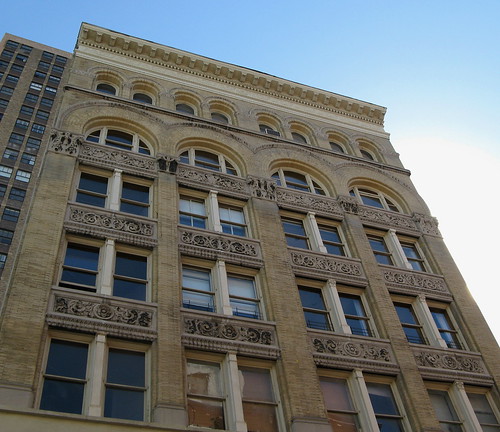
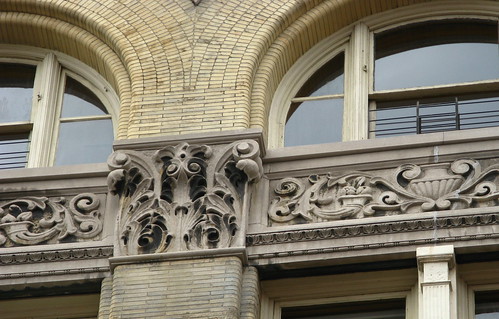
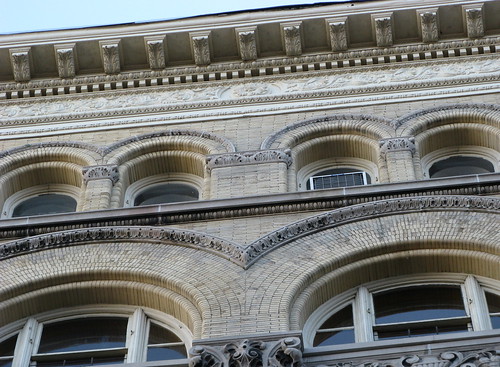
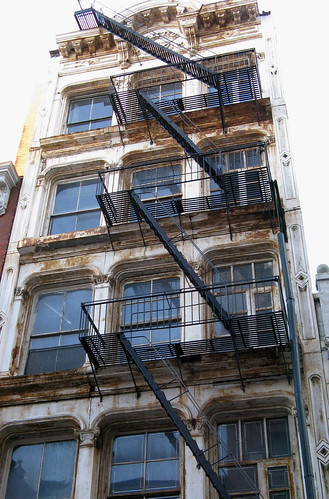
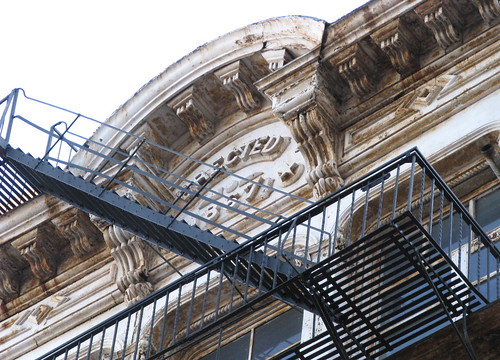
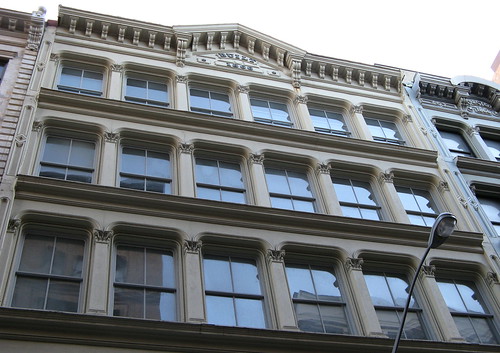
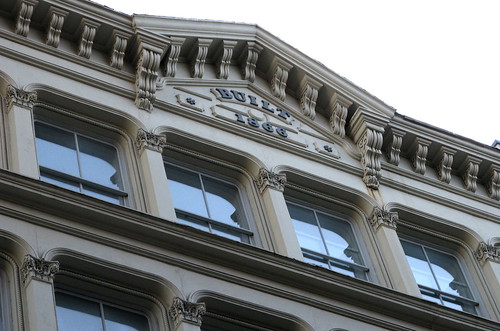
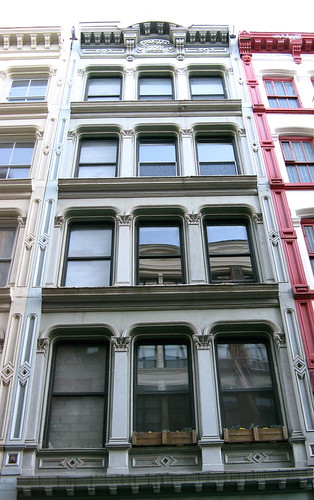
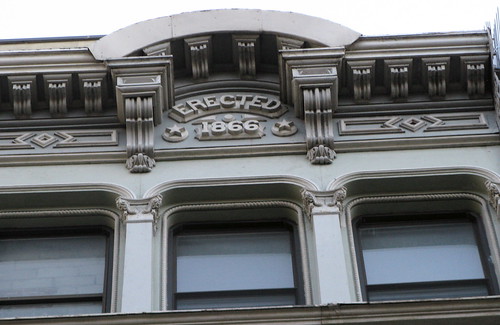
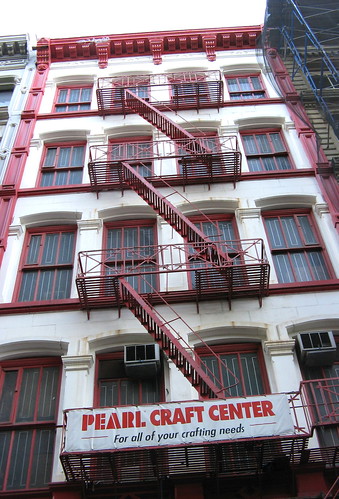
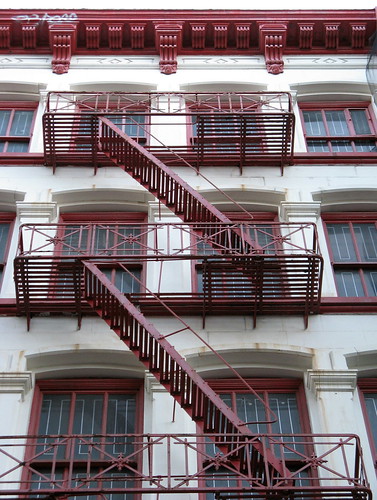



Thanks, Susan, for another look into a less familiar corner of New York. As visitors to NYC, and as you know some of us come from a long way off, it is too easy to spent time in the popular tourist spots or following the Sex and the City/Friends/Seinfeld or whatever trail. If that is your thing then go for your life, but it is so much fun just wandering around exploring.
On my last visit with some friends we spent our first morning, a Sunday, wandering around SoHo and Greenwich Village. It was early May, crisp but sunny, so we picked a likely looking cafe and had a delightful late breakfast/early lunch and did a bit of people watching.
It was a lovely way to ease our way into NY madness.
Just came across a reference to this street in [David] McCullough’s book The Greater Journey. It seems the sculptor Saint-Gaudens’ father had a shop there.
Cyn,
Thanks for calling our attention to David McCullough’s reference to the father of Augustus Saint-Gaudens having a shop on Lispenard.
I found some additional references and highlights about this time in Saint-Gaudens’ life. In the two-volume work, The Reminiscences of Augustus Saint-Gaudens, the sculptor noted that his family moved from the Bowery to 41 Lispenard St. “Here father branches out for himself, hiring a whole building, and subletting it to one or two tenants….” Saint-Gaudens said. (I shall have to check out 41 Lispenard further.)
His father was a cobbler. A New Yorker article cites his father’s shop on Lispenard Street and the sculptor’s “rough-and-tumble boyhood downtown.”
An Obit magazine piece similarly discusses the shop and the sculptor’s early days in the neighborhood. Saint-Gaudens later recalled the life of the streets, of “heroic charges and countercharges down Lispenard Street, bold forays into the enemy’s ground … [which] dominated life then as much as anything has since,” according to the article.
In his memoirs, Saint-Gaudens described difficult times in attending the North Moore Street School following his family’s move to Lispenard, specifically the street fighting among gangs. He said he was “unusually combative and morose” but also remembered the relief of Sunday outings, such as a trip he and his brother Andrew took across the North River to New Jersey’s Elysian Fields.
What one can learn reading and walking down these New York City streets! Thank you!
Susan
Susan-
I just enjoyed the most delightful “walk” with you along Lispenard St. Your photos and well-researched background information really made the area come alive for me. Thanks for including the link to that report which provided fascinating history on that section of Manhattan.
I find it curiously refreshing that this neighborhood has not been gentrified….yet.
Hi, David,
Thanks! So happy that you enjoyed the piece, and I’m very glad it inspired your own recollections of easing your way around New York. I felt vicariously that I was wandering around the Village and SoHo with you.
I’ve learned a lot from you and how you find so many gems of Deco buildings in the nooks and crannies of city and towns,for your blog and endeavors. And you’re right — I think so often people come to New York to take in the sights, but do enough of them really see the city?
Again, thanks,
Susan
Gretchen,
So happy that you found the walk to be delightful — that was definitely my intention, to share this with others. I know what an observant walker you are, so I’m thrilled.
And yes, isn’t that report on Tribeca East something? I feel like each one of these reports is a gold mine in and of itself.
I understand and feel some definite sympathies with your feelings about gentrification. Some gentrification is good – it keeps the city reinventing itself, in my view. But when it is the kind of gentrification that prices out a lot of people and makes things so luxury-oriented, then that is a different matter.
Again, thank you, and enjoy your walking!
Susan
Susan,
It’s wonderful how your site leads us to other great sites! Based on your link to David’s Art Deco blog, and with my interest in Art Deco and Art Nouveau, I had a look at his Art Deco photos, which are great! So glad examples of that period have survived and are documented.
Thank you, Susan, for the lead and thanks, Gretchen, for following it and complimenting my photos. As you can see it is a passion/obsession of mine.
A wonderful post, Susan! I had never heard of this street with so many beautiful buildings. I’ll try to get there on one of my photo tour trips to NYC this year.
Your photographs were great and your descriptions elegant. Plus, I learned a new term… bull-nose brick
Steve,
Lispenard is a gem. Thank you so much, especially coming from someone with such a keen eye.
“Bull-nose brick” was a new one on me, too. It was an excellent choice for that building.
Happy exploring!
Susan
In the late 1940’s my mother found Mr. Briegers on Lispenard St. He sold the ends of clothing lines from very best stores uptown sans labels. He had been in this business from about the 1st World War. He was a small man, almost elfin. The great prices allowed us to splurge on good English shoes from Wanamaker’s over bt Grace Church. As my father had gone back to engineering school (Brooklyn Poly) after the war, money was tight.
I have recently seen a house we lived in and we did not buy for $30,000-40,000 sell for $2 million plus.
Though brought up in Greenwich Village and schooled at Bank Street Nursery School, Little Red, City and country, and Walden, I now see Manhattan as a city moated with money. When the Times can only find TWO mom and pop stores in GV the neighborhoods are really just names.
Peter,
Thank you for giving us a picture of Lispenard in a different era, one that makes me see that despite our so-called “riches,” we have lost something. There is something just wrong in that place selling for $2 million plus.
And I can appreciate a store selling the ends of those clothing lines from uptown stores sans the labels.
I did not see that Times piece, but I will look it up.
Thanks for enriching our understanding of this wonderful street.
Susan
In the 1830s the headquarters of General Winfield Scott, head of the U.S. Army, was on Lispenard Street.
It is referenced on page 3 of “Fifty Years Observations of Men and Events” by Erasmus D. Keyes, an aide to General Scott. Google Books has a full text version of the book.
Sandy,
Thank you for that very interesting info about General Scott. I didn’t know it. I looked at the reference, too, and Erasmus D. Keyes describes quite a cold first encounter when he arrives at the general’s Lispenard Street headquarters.
Always amazing to think of the history that has happened on a single New York street!
Gratefully,
Susan
Hi. Fun to find your photos and guide to Lispenard St. I was looking for information as part of some family research. An ancestor of my wife’s named Henry Augustus Sand was born at 62 Lispenard in the 1830s. He died heroically at Antietam and is buried with a fine monument across the river in Green-Wood Cemetery. Apparently, the house he was born in was taken down to make way for the impressive 1895 building at 60-62 Lispenard in your photos. Do you know of any sources about earlier buildings on Lispenard?
Jeff,
In addition (to the suggestion below), I looked at the report designating Tribeca East as a historic district, from the New York City Landmarks Preservation Commission. On pages 225-226, you will find the listing for this address, which is Tax Map Block Lot 194/32. This information would be helpful for you to research this address and what existed before, at the Municipal Archives.
The designation report does not say much about the prior structure, except to note that the current building replaced two 2-story masonry dwellings that had been altered to accommodate a restaurant and store.
I’ll check around and see what else I find out.
Susan
Thanks so much! I will check out those sources. Jeff Richman’s essay is very well-done. Also, I am second author with another family member on a book that is a compilation of all of Henry’s letters home, watercolors of the Antietam battlefield done by his older sister a year after the war, and other related documents. It is going to be published by McFarland Press sometime soon. Tentative title: Crossing Antietam: The Civil War Letters of Captain Henry Sand; Peter Sand and John McLaughlin. (My given name).
Cheers, Jeff
Jeff,
What wonderful news about your upcoming book. Please keep the Mindfulwalker.com audience and me posted about it. Yes, Jeff Richman’s essay on the Green-Wood cemetery page is very good, and I found its account of Henry Sand very moving.
It’s great that your book with Peter Sand will include the watercolors of the Antietam battlefield that his sister painted. What a loss this family endured!
All the best with your research on the Lispenard Street address. The Municipal Archives, at 31 Chambers St., should be a good source. Systematic property records go back to 1866, to my knowledge, so the archives should have something on the earlier property (even if it doesn’t go back to the birth year of Henry Sand).
I would try the Municipal Archives as well as the Manhattan office of the New York City Department of Buildings.
Here is a resource page from the New York City Landmarks Preservation Commission that will help with both of those as well as other possibilities.
I’d be interested in hearing about your follow-up research on this address.
Warm regards, and cheers,
Susan
Jeff,
Thanks for dropping a note here at Mindfulwalker.com, and I’m very happy that you enjoyed the photos and guide to Lispenard.
That is quite an amazing story of family history, about Henry Augustus Sand.
For others who do not know of his story and heroism, here is an essay about your wife’s ancestor from the historian at Green-Wood Cemetery.
I plan to read more about Captain Sand, since you have written to me about him.
Have you tried the New York City Municipal Archives as one resource for information about the earlier buildings at Lispenard? Let me give this some thought, and I’ll suggest additional possibilities.
Warm regards,
Susan
The street is prominently featured in Hanya Yanagihara’s A Little Life, Booker-nominated and interesting.